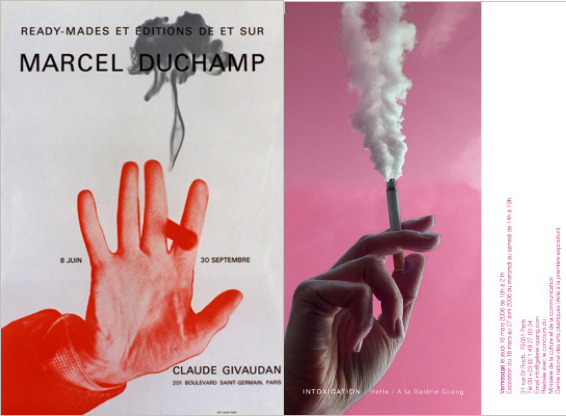The Smoking Lamp is an object that amplifies the
personal choice of smoking or not smoking in a public environment. The
lamp is deliberately paradoxical, at once inviting the public to smoke
whilst at the same time signalling their transgression. Designed as a
funnel that terminates with a ring of light, the lamp changes from a
bright white to a warm pink if it detects nicotine smoke beneath it.
The light emitted corresponds with the new situation, illuminating the
particles being exhaled by the smoker, and placing the smoker within a
theatrical scene. The light situation calls to mind the dramatic
interrogation rooms from celluloid history, spotlighting the smoker,
exposing them and their activity. The red hand and face gestures of the
smokers become the focus of attention while the non smoking public,
cast as the spectator, watches the extraordinary phenomenon that was
first described by 17th century Europeans - before the word was
verbalised - as “drinking smoke”.
Official prohibition of smoking in public spaces has a history as long as tobacco usage itself. The most recent case in Europe was under the Nazi regime in Germany campaigned against smoking with slogans such as ‘Die Deutsche Frau raucht nicht’ (The German woman does not smoke), cigarettes were rationed and banned from all public places as part of a wider programme to attain a more ‘organic’,‘natural’ and ‘biological’ way of life. Restricting individual freedom was justified for the greater good of society: to ensure the future of the German genotype (1). As a consequence of such prohibitive measures, smoking has been repeatedly used a symbolic protest against political oppression and to express liberation: In revolutionary Prussia, every smoker seen on the street was suspected of being a “dangerous democrat”(2) whilst in nineteenth century France, smoking acquired new symbolic significance for the female emancipation movement, when rebels like George Sand and Lola Montez shocked the social mores of their time by smoking deliberately in public. Gender bias in smoking lingers on today in the adoption of cigars, the ultimate symbol of power and masculinity. The cigar was famously used as a substitute phallus in the Clinton–Lewinsky affair and Marcel Duchamp anticipates such a situation in his 1967 poster design for "Ready-Mades et Editions de et sur Duchamp" (3) where a photomontage shows a male hand holding a cigar below a rising cloud of smoke in the form of female genitalia. Duchamp’s image was the departure point for the invitation to INTOXICATION (4) at the Galerie Vanessa Quang in 2006. But this time the gender relations were inversed; a woman's hand holds a cigarette that is superimposed with an industrial smoke emission. Today, as intolerance of smoking in public increases, the smoking lamp is designed for tobacco’s new ambiguous status: at a moment when smoking is not quite yet a sign of social rebellion but the space for a few puffs are (or are about to be) greatly reduced. If the cultural historian Wolfgang Schivelbusch observed that “smoking creates both a feeling of activity in leisure and one of leisure in the midst of activity”, then the Smoking Lamp serves as a device to augment smoking activity to the point of absurdity. Neither for, nor against, the lamp simply magnifies the language and culture of smoking, amplifying the personal choice that each individual makes.
The smoking Lamp is part of a larger artistic research into the question is how to generate real-time consciousness of air pollution. The effects of contemporary pollution are slow and imperceptible: a single cigarette will not kill, but a continuous use might - we consume now and we pay later. Like all the projects from Pollstream series (see hehe.org/pollstream), it reduces the time delay between our actions and their effects, cause and effect are scaled into the real-time decision making process, posing the question: to pollute or not to pollute? Smoking Lamp brings alive the ugly stuff that goes into our lungs - the cigarette smoke itself. And as vapour particles are translated into red light and noisy oscillations one becomes aware of those little clouds we inhale and exhale. As a design, a product, an installation, a work of art, it does neither offer humiliation nor affirmation for the smoker - it turns the beast into the beauty and amplifies our choice - here and now.
1)Robert N. Proctor, "Racial Hygiene", Harvard, 1988, p239 “In July 1939 Reich Fuehrer Leonardo Conti founded a Bureau against the dangers of alcohol and tobacco, under his personal leadership. The Reich Health Office at about the same time ordered an investigation of the effects of nicotine on human chromosomes and offered substantial prize money for the best research in this area.”
2)Wolfgang Schlievelbusch: “Tastes of Paradise, Der Geschmack und die Vernuft”, 1980, Vienna, p120
3)Marc Partouche, “Marcel Duchamp, sa vie même", al dante / &, 2005 Romanville, p17
4)Left exhibition poster, Marcel Duchamp, 1967; Right
exhibition invitation “Intoxication”, HeHe, 2006
